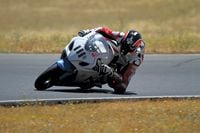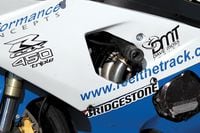Sitting in the van riding to the racetrack, I had second thoughts. This was the third time in a span of nine months I had signed up to hurl myself around a racetrack I had never seen on a bike I’d never ridden. Road Test Editor Ari Henning was racing as well (but he already knew the track), so he took advantage of the eight-hour drive to brief me on Thunderhill Raceway, in Willows, California, describing at meth-addict speed the nuances of the racetrack. “Then you peel left up this hill and it’s totally blind, so you’re full tuck with the throttle wide open, and you have to look for the water tower on the horizon. It’s way off in the distance, but you’ll see it.”
There would be, quite literally in the case of the uphill left-hander, more to the track than would meet my eyes. And the same applied to the bike. An unassuming—obsolete even—2005 Suzuki GSX-R600 with white race bodywork, an aftermarket exhaust, and rearsets. But it’s what this Gixxer does not have that makes it special—and that is the number-two cylinder. It has been disabled deliberately, and the result is surprising.
Thumbing the engine to life for the first time, the “Cripple Triple” settled into what can only be called a predictably rough idle. Ari and I took turns blipping the throttle and listening intently. “Yep,” he smirked, “sounds like it’s missing a cylinder.” I pulled my helmet on for first practice not knowing what to expect. As I careened around Thunderhill the first few times, searching desperately for water towers on the horizon, the Gixxer triple surprised me by being totally amicable. Power was plentiful in the upper two-thirds of the rev band, and the stutter in the exhaust note dissipated at high revs too.
Rolling on standard 600-sized Bridgestone slicks, the GSX-R450 clung to corners and inspired confidence. The bike was egging me on, and it was terrific. I pulled off the track totally surprised at what I was riding; it didn’t feel like the Franken-bike I was expecting at all.
Before I go further, let’s address the question you undoubtedly have: Why would anybody take the trouble to deactivate a cylinder? It wouldn’t make any sense on the street, you’re right, but when it comes to club racing, the resulting 450cc three-cylinder powerplant has the potential to restore life to a dying class.
More venerable readers might remember certain street-legal 400s from two decades ago. Models like Yamaha’s FZR400, Honda’s VFR400, and Kawasaki’s ZXR400 did create a legitimate displacement class, but the US was mostly left out of the game. Apart from Yamaha’s FZR, 400cc sportbikes weren’t widely available here, even during the peak of their popularity in the early to mid-’90s. That didn’t stop American club racers from latching on to this breed of welterweight machines (some of them gray market) and dragging knees to their hearts’ content.
As time passed these models went out of production, and especially in the last few years it has become increasingly difficult to find replacement parts. That’s about the time that Dave Wallis, an amateur racer from Northern California, came across the GSX-R450 concept. Wallis gives credit for the design to a Kiwi named Chris Osborne, and when Wallis offered to buy the formula, Osborne shared it free of charge. With the help of fellow lightweight racing fanatics Dave Moss (feelthetrack.com) and Patrick Ho of Performance Concepts (perf-concepts.com), Wallis tackled the task of recreating the Cripple Triple.
“It’s actually really simple,” Wallis explained. “A lot of people think we’re cutting off cylinders, welding on plates, and modifying cranks, but we’re not. It’s way easier than that.” Here’s the recipe they used in a nutshell: Remove the valves from cylinder #2 and fill the guides with RTV silicone. Install a freeze plug at the base of the #2 head-pipe to keep exhaust gases from getting sucked back into the airbox. Cap the intake stack for cylinder #2 (or cut a hole in the airbox and run it to open air). Lastly, run a loop in the fuel-injector lines to trick the ECU into thinking all is peachy, and there you have it; a GSX-R450 is born, with small modifications in the intake, exhaust, and top-end, all for a couple hundred dollars in parts.
There is slightly more to it, but that’s essentially all it takes. The piston in the second cylinder flies around at 15,000 rpm, moving air but nothing else. The result is horsepower in the mid-60s, with predictable and linear power. “A really fresh one might make 70,” Wallis admits, “so the power isn’t dominant, but the torque’s about the same as the V-4 400s are putting out too, low or mid-30s.” Perhaps the most compelling part of this modification? It’s all reversible. Silicone can be removed, valves replaced, intake and exhaust opened, fuel flow restored, and the GSX-R450 becomes a 600 again.
But now back to the track and why this is such a convincing and thrilling race project. We discussed why racers like the Daves (Wallis and Moss) are interested in the concept; it reinvigorates a dying class of club racing that they have come to love. But there are a few other reasons a Cripple Triple makes sense. One is availability. Track-ready GSX-R600s from roughly 10 years ago, for example, are fairly obtainable—and typically for much less than a current-generation racebike would cost.
Another beneficial side effect of disabling a cylinder is that the chassis immediately becomes under-stressed, which helps explain why my confidence was peaking even in the first couple of sessions on the track. Four-pot Tokico calipers up front aren’t anything special, but slowing down 70 hp instead of 110 will make any brakes feel better. The same goes for the transmission, clutch, and tires. Suspension and handling are up to 600cc-spec, too, and competing with now-antiquated FZR400s and VFR400s means the bar is set lower than racing against cutting-edge middleweights.
And then there is the overriding ideology on which so many Motorcyclist sermons have been based; slow bikes are fun. Fewer horsepower let our mortal brains catch up with the curbs, apexes, and water towers flying by and actually sink our teeth into the experience of riding a motorcycle—in this case, going around a racetrack as fast as I could.
By the time my race was called I had come to grips with the fast, sweeping (and often blind) corners of Thunderhill and was genuinely looking forward to the heat of battle. After a crummy start—clutch engagement on these triples is still an issue—I worked my way forward and set out after the race leader, riding an RVF400. Power was comparable, as promised, and sure enough the nearly 10-year-old chassis proved it could sail around a track as well as any of the other bikes in the class.
As the burble from the exhaust at low rpm evened out I tuned my ear to shift where the power drops off—about 13,500 rpm, though it revs to nearly 15,000—and tried not to let the tachometer dip below 10,000. Eventually I picked my spot and took a stab at the lead, and after narrowly escaping another challenge from an approaching ZXR400RR the Cripple Triple and I crossed the finish line first.
After the race I realized it only got better; Being 6-foot-2, I appreciated the plebeian power packaged in a full-size bike that I could ride all weekend without feeling cramped. I also learned that a fellow racer with a clean, matte-black GSX-R450 had completed his project for $1,800. That’s a used GSX-R600 and the parts to cripple it for less money than you can expect to spend on almost any race-prepped motorcycle.
I’m not the only one high on this notion either. In the months since I raced at Thunderhill the Cripple Triple cult has matured. The growing band of racers are experimenting with new ways of streamlining the dead cylinder—grinding the lobes off cams so that the valves can stay in place and writing software to ease the complexity of only fueling three of four cylinders.
I scoffed when I heard the idea of a disabled 600cc sportbike reinvigorating a roadracing class. When it comes to performance bikes, I always thought “less is more” was just a saying for those whose only salvation was to slow down for fear of breaking a hip. But this formula absolutely translates to fun on a racetrack, regardless of skill level. I’m smitten and have already started shopping for used GSX-Rs.














/cloudfront-us-east-1.images.arcpublishing.com/octane/VZZXJQ6U3FESFPZCBVXKFSUG4A.jpg)
/cloudfront-us-east-1.images.arcpublishing.com/octane/QCZEPHQAMRHZPLHTDJBIJVWL3M.jpg)
/cloudfront-us-east-1.images.arcpublishing.com/octane/HXOUJXQWA5HBHGRO3EMJIGFMVI.jpg)

/cloudfront-us-east-1.images.arcpublishing.com/octane/3TIWWRV4JBBOLDVGRYECVVTA7Y.jpg)
/cloudfront-us-east-1.images.arcpublishing.com/octane/KIX5O23D5NAIBGFXBN3327DKZU.jpg)
/cloudfront-us-east-1.images.arcpublishing.com/octane/7GJYDUIPXRGMTMQKN6ONYOLBOU.jpg)
/cloudfront-us-east-1.images.arcpublishing.com/octane/MUQLOVLL2ZDGFH25ILABNBXKTI.jpg)
/cloudfront-us-east-1.images.arcpublishing.com/octane/TNOU5DNE2BC57MFPMGN2EIDXAM.jpg)
/cloudfront-us-east-1.images.arcpublishing.com/octane/GTCXACQGJ5HAPDTGWUQKDEH44E.jpg)
/cloudfront-us-east-1.images.arcpublishing.com/octane/S35YGSEMEZB4BLTDJTSZPF4GLA.jpg)
/cloudfront-us-east-1.images.arcpublishing.com/octane/5UOT6HPX2JFMRJAX6EH45AR4MQ.jpg)
/cloudfront-us-east-1.images.arcpublishing.com/octane/OKWOJWAKP5EP3OACCRRWPCIX2Q.jpg)
/cloudfront-us-east-1.images.arcpublishing.com/octane/2WF3SCE3NFBQXLDNJM7KMXA45E.jpg)
/cloudfront-us-east-1.images.arcpublishing.com/octane/G4MG6OUCJNBSHIS2MVVOTPX65E.jpg)
/cloudfront-us-east-1.images.arcpublishing.com/octane/IIGGWFOTOJGB7DB6DGBXCCMTDY.jpg)
/cloudfront-us-east-1.images.arcpublishing.com/octane/QSTCM6AVEZA5JJBUXNIQ3DSOF4.jpg)
/cloudfront-us-east-1.images.arcpublishing.com/octane/U4I7G625B5DMLF2DVIJDFZVV6M.jpg)
/cloudfront-us-east-1.images.arcpublishing.com/octane/B6XD6LS6IVCQPIU6HXDJSM3FHY.jpg)
/cloudfront-us-east-1.images.arcpublishing.com/octane/ICL63FEDDRDTTMINYICCEYGMDA.jpg)
/cloudfront-us-east-1.images.arcpublishing.com/octane/FCGZHQXRBZFLBAPC5SDIQLVF4I.jpg)
/cloudfront-us-east-1.images.arcpublishing.com/octane/WNOB6LDOIFFHJKPSVIWDYUGOPM.jpg)

/cloudfront-us-east-1.images.arcpublishing.com/octane/X33NU3E525ECRHXLNUJN2FTRKI.jpg)